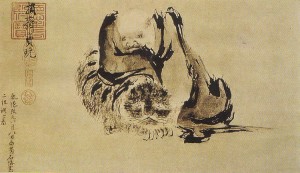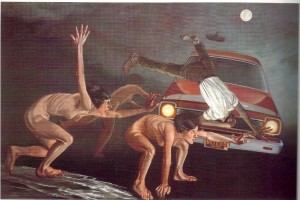The Art of Shi K’o and Alfred Leslie
 A comparison of the tenth century Shi K’o drawing of Zen Master and a Tiger to the contemporary Alfred Leslie painting entitled The Accident presents to the viewer a jarring yet contemplative dynamic.Shi K’o’s work is a picture of only two figures,both illustrated in vague strokes of black and grey with a blank white background.The absence of background artifacts on the blank white surface serves to emphasize the form of the featured subjects.The subject matter seems to suggest the greatest of polarities;instead, the figures blend into a unified focal point.The somewhat rotund man seems to almost lean on the prone tiger’s back with his right arm.His left arm braces him against the ground almost hugging the jungle animal.Both the robed master and the tiger look directly out from the drawing.In the bottom center it is unclear whether one sees the tiger’s claw or the hand of the master.Off to the right of the two figures is a long,dark curved object near the Zen master’s knee.It could be a snake or only an abandoned tassel from the monk’s robe.This ambivalence of form suggests the Zen essence of the depiction.
A comparison of the tenth century Shi K’o drawing of Zen Master and a Tiger to the contemporary Alfred Leslie painting entitled The Accident presents to the viewer a jarring yet contemplative dynamic.Shi K’o’s work is a picture of only two figures,both illustrated in vague strokes of black and grey with a blank white background.The absence of background artifacts on the blank white surface serves to emphasize the form of the featured subjects.The subject matter seems to suggest the greatest of polarities;instead, the figures blend into a unified focal point.The somewhat rotund man seems to almost lean on the prone tiger’s back with his right arm.His left arm braces him against the ground almost hugging the jungle animal.Both the robed master and the tiger look directly out from the drawing.In the bottom center it is unclear whether one sees the tiger’s claw or the hand of the master.Off to the right of the two figures is a long,dark curved object near the Zen master’s knee.It could be a snake or only an abandoned tassel from the monk’s robe.This ambivalence of form suggests the Zen essence of the depiction.
The full,mighty body of the tiger is on the ground,yet it is not completely relaxed.A hint of tension in its posture indicates that it could spring into action at any time.The expression on its whiskered face is that distinctive and inscrutable feline mixture of curiosity and independence.And this despite the fact that the Zen master’s body weight appears to press on the beast.The annular form of the man strives to dominate the overall portraiture if only because it is slightly larger and higher in the complete structure.His determined but also somewhat cryptic facial expression and slightly hunched position offers its own ostensibly simple yet actually multidimensional bid for interpretation.He seems to look at the viewer with a calm but intent comprehension that proclaims he shares with his fellow creature a capability for fierceness and focused vigilance.This symbiosis is underscored by the picture’s grey shading and black semi-circular lines that suggest the composition of not two but one single entity.
On initial perusal this Japanese depiction brings to mind two well known Western archetypes.The first is the familiar biblical narrative of Daniel in the lion’s den.Like Daniel the spiritual power of the Zen master transcends and transforms the wild beast.The animal is not only compliant in contrasts to its characteristic ferociousness,but in Shi K’o’s work of art his very being harmonizes with that of the master.Thus the inherent separateness of the two souls dissolves.
The second archtypical image recalled is that of the nineteenth century English poet William Blake’s poem The Tyger:
When the stars threw down their spears
And water’d heaven with their tears
Did He smile his work to see?
Did He who made the Lamb make thee?
The savage predator and the meditative holy man come together as manifestations of the same Source.Zen Buddhism sublimates humankind’s brutish nature into that of strong focused awareness.As the face of the Zen master looks out to the viewer he displays at once a keen consciousness of the physical dichotomy of the tiger and himself but at the same time is totally mindful of their transcendent sameness.In both figures their semi-prone postures belie a sharp mental acuity.What could be an oppressive dominance by the Zen master and a docile capitulation by the tiger renders itself instead as a synergistic union of power and intelligence of the highest order.
The somewhat incidental object of the nearby tassel or snake like figure adds to the paradoxical koan-like gestalt of the entire scene.
 In jolting contrast, Alfred Leslie’s The Accident is semi-naturalistic and yet horrific in theme and composition.It is Leslie’s impression of an actual event.The event is the hit and run murder of poet and friend Frank O’Hara in the summer of 1966 at Fire Island, a beach community in New York state.
In jolting contrast, Alfred Leslie’s The Accident is semi-naturalistic and yet horrific in theme and composition.It is Leslie’s impression of an actual event.The event is the hit and run murder of poet and friend Frank O’Hara in the summer of 1966 at Fire Island, a beach community in New York state.
The painter’s portrayal takes on the scope of a modern apocalyptic myth.In the representation,four human figures are shown in various stages of pandemonium,terror and injury.On an ocean washed night of a full moon,a wide dull crimson colored,late model American automobile appears to roar toward the viewer.Its slightly off center angle of approach conveys high velocity and impending doom.The car’s front grill and hood impact with the figure of a male pedestrian.He is illuminated both by the light of the vehicle’s headlights and the full moon.The man faces toward the incoming machine and his body is tossed feet high in front and above the careening weapon of death.He is dressed in a white shirt and dark slacks,but barefoot.His one shoe is seen thrown above’s the car’s roof.Upside down the victim seems to be making a pathetic and pointless attempt to protect himself and prevent the projectile’s crushing momentum.One pitiful hand grips his head in battered agony.No driver is visible behind the darkened windshield and no blood is seen.
The other three human figures are nude females in exaggerated postures of hysteria and response to the cataclysm.Two are slightly off center in the foreground.The third is back and to the left of the automobile.Rather than suggesting the Reubensque images of ladies at leisure at the seashore,their emaciated bodies of grey,shadowed flesh conjure up images of Dachau and Auschwitz.The woman near the side of the car vainly pushes against it as it speeds by her.The figure farthest to the left with an anguished,fearful open mouthed expression flails her arms in a gesture of pain and hopeless preventiveness.She is in a semi-crouch looking at the collision with dread and disbelief.The third nude female crouches almost in the two point position of a track runner.She stares off away from the murderous,oncoming vehicle although she appears to be in is intended path.Her left arm extends outward in the direction of her intense gaze.There is some fear in her eyes but not the expression of panicked affliction displayed by her companion.The entire spectacle is surrounded by ominous,dark shadings of bluish fog and mist.The pervasive effect is one of decimated,agonized physicality.
Alfred Leslie paints for a contemporary audience.He is also a film maker.He is well aware of the modern audience’s satiation with shocking imagery.In The Accident he freeze frames a single traumatic event and skillfully enhances it context of modern myth and confrontational inquiry.Do the three nude women represent the poet’s muse?Is this the way that the accident in fact occurred?
The bright full moon,inspiration for poetry and song is instead now an indifferent witness to the catastrophe taking place before it.the single hapless nude to the left center of the picture is helpless in her attempt to prevent the carnage.Te creature to the far left’s outstretched left arm is no defense against the speeding homicidal machine.The remaining nude figure squats and extends her hand in an empty gesture of self-protection.
The monstrous scene is one of technology gone berserk.It is beyond being simply misguided.It is without a helmsman.Its only direction is towards destruction and death.Even Mary Shelley’s Frankenstein was a putrid parody of humanity.Alfred Leslie depicts a horrendous instrument of mechanization with no connection whatsoever to humanity except to annihilate it.
The vehicle is the brownish red color of a blood stain.The lettering on the license plate is orangish red.”New York 66″ can barely be discerned as a foreboding clue.In 1966,the year of Richard Speck’s heinous, murderous crime;the year of the Austin,Texas university sniper and the year of the disastrous escalation of American combat in Southeast Asia.and now we see America’s most conspicuous object of consumer consumption on a rampage of butchery.Madison Avenue entreats,”See the U.S.A. in your Chevrolet”,unless of course in some,sick bizarre Stephen King twist of unfortunate circumstance,the auto seizes the pedestrian and turns him into road kill.”Let Hertz put you in the driver’s seat”,except if corporate America’s most ostentatious artifact which is”unsafe at any speed”,revolts and the slave transforms the master into a bloody hood ornament.The Accident is a microcosm of Guernica.It is a segment of a modernistic,demented Hieronymus Bosch landscape with futuristic portents.
Shi K’o’s depiction of the Zen Master and the Tiger relates to Alfred Leslie’s The Accident in profound and reflexive layers of interpretation.Although they are centuries apart in their conception and millenniums apart in their technical representations,they are linked thematically.Both deal with survival and its analog spiritual salvation.
The human figure in the Shi K’o portrayal is at peace.This peacefulness allows him to look at the viewer with directness and to embrace a creature that has the potential to devour him.The black and white tone lack the shrillness of Leslie’s painting but not the immediacy.The Zen master is in the center of the picture and his mental perspective is centered also.He is touching the earth and embracing life.
In nightmarish contrast,Leslie’s prime figure is literally upended and tossed off the earth as if a macabre rag doll.An invention of humankind’s linear thought system has singled out its creator for obliteration by a most savage method.The embodiment of civilization’s salvation,the poet,is impaled by the outgrowth of the species’ inability to harmonize with its environment.The living,inspirational component’s of man’s spiritual essence are horrifically dispersed in fear and agitation.
Antithetically the Shi K’o portraiture demonstrates a forceful antidote to Western mankind’s limited and ultimately damning one dimensional non-grasp of the realities of human existence.The Zen Master and the Tiger illustrate with exactitude the sometimes abstruse concept of authentic,complete mindfulness.the audience is allowed to breathe in an aesthetic that at once edifies and therefore empowers.In this way Alfred Leslie’s harrowing vision is not just survived but transformed into an ennobling aspiration.